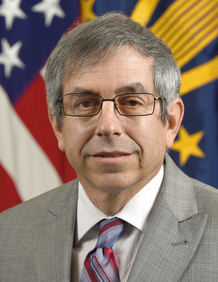Symposium Home Agenda Abstracts and Bios
Dr. Mark Lewis
Director of Defense Research and Engineering for Modernization

May 19, 2020 at 12:30
Dr. Mark J. Lewis is the Director of Defense Research and Engineering for Modernization. In this capacity, Dr. Lewis oversees investment and capability analysis of the Pentagon’s modernization priorities outlined in the National Defense Strategy. He has oversight of the nine assistant directors assigned to those modernization portfolios, working in collaboration with the two technical directors, and their roadmaps – the comprehensive strategies to manage, provide oversight and guide choices for each modernization priority area. These modernization priorities include 5G; Artificial Intelligence and Machine Learning; Autonomy; Biotechnology; Cyber; Directed Energy; Fully Networked Command, Control, and Communications; Hypersonics; Microelectronics; Quantum Science; and Space.
Prior to this role, Dr. Lewis was the Director of the IDA Science and Technology Policy Institute where he lead a team of researchers providing analysis of science and technology issues for the Office of Science and Technology Policy in the White House, the National Science Foundation, the National Institutes of Health, NASA and other federal science agencies. Dr. Lewis served as the Willis Young, Jr. Professor and Chair of the Department of Aerospace Engineering at the University of Maryland, President of the American Institute of Aeronautics and Astronautics, and was the founder of both the Center for Hypersonics Education and Research and the NASA-Air Force Constellation University Institutes Project. He has also served on various advisory boards for NASA, the Defense Department, and the Air Force, including two terms on the Air Force Scientific Advisory Board.
From 2004 to 2008, Dr. Lewis served as the Chief Scientist of the U.S. Air Force. During his tenure, Dr. Lewis expanded basic research support, focused efforts on launch vehicle technologies, established major international programs and contributed to the Presidential National Aeronautics Executive Order.
Dr. Lewis attended the Massachusetts Institute of Technology where he received a Bachelor of Science degree in aeronautics and astronautics, Bachelor of Science degree in earth and planetary science (1984), and both a Master of Science degree (1985) and a Doctor of Science degree (1988) in aeronautics and astronautics.
Dr. Walter S. Scott
CTO of Maxar

May 20, 2020 at 12:30
In 1992, the Cold War had only just ended, and Congress had just passed legislation enabling the commercial satellite imagery industry, and that industry was born. Today, commercial satellite imagery is ubiquitous, whether it is on our mobile phones, or serving as the eyes in space for US allies, or providing over 90% of the foundation imagery to the US government. Dr. Walter Scott, founder of the commercial satellite imaging company DigitalGlobe (now part of Maxar), will describe the journey of the industry from its founding to today, discuss how it supports the warfighter, and speak to where the industry is headed in the future.
Dr. Scott is Maxar’s Chief Technology Officer. He oversees the development of Maxar’s commercial remote sensing systems (from DigitalGlobe), R&D, software architecture, and government relations / public policy.
Dr. Scott founded DigitalGlobe in 1992 as WorldView Imaging Corporation, which was the first company to receive a high resolution commercial remote sensing license from the U.S. Government (in 1993), under the 1992 Land Remote Sensing Policy Act. WorldView became EarthWatch Incorporated in 1995. Dr. Scott managed the development of all of the company’s commercial remote sensing satellites. He secured the first-ever export license for launch of U.S.-manufactured imaging spacecraft on Russian launch vehicles (Start-1 and Cosmos). The company became DigitalGlobe in 2001, and with the launch of the QuickBird-2 satellite that year, offered the world’s highest resolution commercial satellite imagery. Today, DigitalGlobe operates a 5-satellite imaging constellation with the best revisit and greatest capacity in the industry.
From 1986 through 1992, Dr. Scott was with Lawrence Livermore National Laboratory (LLNL). He began as Project Leader for Computer Aided Design Tools for the Laser Pantography Program, developing tools to aid in the design of wafer scale integrated circuits manufactured. In 1987, he joined a small team developing a concept for a highly distributed constellation of space based interceptors for the Strategic Defense Initiative, known as “Brilliant Pebbles.” In late 1987, Dr. Scott became Program Leader for this effort, responsible for creating a series of hardware prototypes and conducting flight experiments. During 1989, Dr. Scott led the program successfully through over 20 reviews of technical feasibility, system performance, military operability, and estimated cost, resulting in the adoption of Brilliant Pebbles for SDIO’s space segment in 1990. In late 1991, Dr. Scott was Assistant Associate Director of the Physics Department and was responsible for development of new space-related programs and identification of promising technologies.
Prior to joining LLNL, Dr. Scott founded and served as president of Scott Consulting, a UNIX systems and applications consulting firm. He developed Unix networking subsystems, and a pioneering email system that used public key encryption for message protection.
Dr. Scott holds a Bachelor of Arts in Applied Mathematics, magna cum laude, from Harvard College and a Doctorate and Master of Science in Computer Science from the University of California, Berkeley. He was a visiting student for a year at Edinburgh University in Scotland.
Dr. Scott was named Entrepreneur of the Year by Ernst & Young in 2004 for the Rocky Mountain Region in the Emerging Technology category, and was inducted into the Geospatial Hall of Fame in 2017.
He previously served on the National Research Council’s Committee on Earth Science and Applications from Space (CESAS) and on the board of directors of the Open Geospatial Consortium (OGC). He currently serves on the board of SSPI (Space & Satellite Professionals International), and is a member of the Landsat Advisory Group, supporting the USGS, and on the AFRL Space Vehicles Directorate Independent Advisory Team.